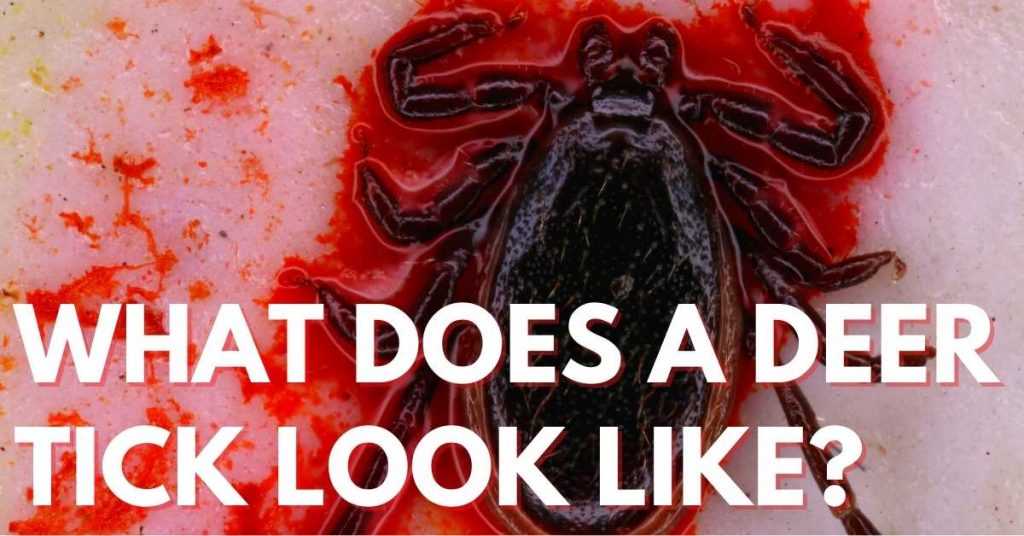
Deer ticks are also known as black-legged ticks. They are scientifically termed Ixodes Scapularis. They are extremely small ectoparasites capable of spreading multiple diseases. The most prominent and dangerous diseases transmitted by deer ticks are babesiosis, Bartonellosis, Borrelia miyamotoi, Anaplasmosis, and Lyme disease. They are present in all 48 states but are primarily found between the East Coast and Texas. Another type of black-legged tick scientifically known as Ixodes pacificus is found on the West Coast, including Oregon, Washington, and California.
Nymph stage and adult stage deer ticks have eight legs. Their legs are long and extend from the round abdomen. Female adult black-legged ticks are distinguished by their orange-brown bodies and the black shield on their back.
It is vital to remember that these ticks require a lot of moisture and shade to survive. Nymph bites, in particular, are the source of most illnesses in humans. A nymph is easier to miss, whereas an adult tick may be spotted and removed during feeding. Because male adult ticks do not feed on blood, only female adult ticks transmit illnesses.
Compared to male deer ticks, female ticks generally sport two shades of the lighter brown-colored torso. After blood ingestion, female deer ticks’ torso will become more rust-colored. Male deer ticks possess a darker and uniform shade of brown with a white stripe around the outside of their abdomen. Deer ticks are flat in their appearance but will increase in size as they feed. They burrow slightly into the host’s skin and stick out of the host’s skin when feeding.
What Does A Deer Tick Bite Look Like?
If you live in areas with a high population density of deer ticks, it is better to check yourself for ticks frequently. Deer ticks attach themselves to the site they want to feed on. They stay attached for a certain duration of time which depends on multiple factors. When they latch themselves onto the host, they release anesthetic substances through their saliva, because of which you do not feel the tick bite.
Additionally, they feed on areas a host usually does not check. This includes skin folds, hairline, areas around your groin, behind ears, underarms, and skin folds below the waist. The bite from a deer tick is generally the size of a pea, tiny. It is likely to appear red on light skin and purple or brown on dark skin. If, over a week, the size of the bite increases over five centimeters, it can be a sign of a tick-borne infection.
How Big Is A Deer Tick?
Deer ticks are extremely small in size. An adult deer tick is the size of a sesame seed, while a nymph tick is the size of a poppy seed. This makes them almost invisible when they latch themselves onto a host. Because of the substance released with the tick’s saliva, the host does not feel the bite when it happens. The small size of the tick provides them with the ease to latch on to their host and feed without the host realizing it. There are several myths about ticks but they might not be true. You can understand more about deer ticks by knowing about their lifecycle.
Life Cycle
Ticks are parasites who feed at each stage of their life cycle. Deer ticks have a four-stage life cycle: the egg, the larva, the nymph, and the adult. This is for both male and female deer ticks. Deer ticks have a two-year life cycle during which they spread diseases such as Lyme disease, Anaplasmosis, and more.
Adult deer ticks are active for two periods in a year. First from October to early December and then from April to May. On the other hand, the larvae are active in the summer months, with their activity peaking in August. The bacteria that is the causative agent of Lyme disease, Borrelia burgdorferi, is usually transmitted via infected nymph ticks. This is because they are minimal in size and go unnoticed.
Larvae are not infected; hence incapable of transmitting Lyme disease. On the other hand, adult deer ticks are big enough to be noticed before transmission can take place. At every stage, the tick only feeds once.
- Egg
After mating, the female adult deer ticks lay eggs in spring. Then these eggs hatch in summer, and the life cycle of a deer tick begins.
- Larva
The eggs hatch in summer as the larvae reach peak activity in August. Larvae are small in size, with six legs. They stay on the ground and wait for a suitable host to brush past them. The preferred hosts for larvae are birds and small mammals.
The larva will feed off their host and swell up by the end. If their host is already infected with the causative bacteria of Lyme disease, the larva is likely to become infected as well. Hosts that reside in Lyme-endemic areas infect ticks that feed upon them.
Since larval ticks are not born infected, they cannot transmit the disease. Instead, they acquire the bacteria from their host and sustain it for the rest of their cycle.
- Nymph
After the larva finishes feeding, it drops off the host and molts into an eight-legged nymph in fall. Nymphs stay inactive through winter and early spring. The activity period for nymphs begins in May.
Nymphs seek a host by questing on vegetation near the ground. They will latch onto their hosts and usually feed for four to five days. If infected during the larval stage, the nymph will transmit the Lyme disease bacteria to their host. Nymphs cause 80% of the Lyme disease cases in humans. If the nymph is not infected, then there is a probability of the deer tick getting infected from their host at the nymph stage.
A point to note is that the peak activity period for nymphs is from May to July. Though nymphs usually look for small animals as their host, more often than not, they feed on humans. Because of their small size, nymphs are most likely to go unnoticed till they are fully engorged because of their small size.
- Adult
The nymph will drop off their host after they complete feeding. Now the nymph molts into an adult deer tick. In fall, they seek hosts and can quest up to three feet above the ground on top of grass blades and shrubs. Their activity peaks in late October and early November. Though up to 50% of adult ticks carry Lyme disease, only a few cases of Lyme disease occur because of adult deer ticks.
They are relatively large and usually get spotted on the host before they finish feeding and transmission completes (under thirty-six hours). They tend to be inactive in temperatures below 45 degrees Fahrenheit. Adult deer ticks are likely to stay inactive till late February, depending on the temperature. When the temperature suits them, they will start questing. This second peak takes place in March and April. They are known as deer ticks since the preferred host for adult deer ticks is deers.
Only adult female deer ticks feed for one week. The male and female adult deer tick may mate on or off the host. Mating is necessary for the female tick to reproduce and complete its cycle. After mating, the female adult deer tick falls off, finds a suitable place to lay eggs, and dies. They lay approximately 3000 eggs after mating. The eggs hatch in summer, and the two-year cycle starts again.
How Deer Ticks Find Hosts?
Like most tick species, Deer ticks use a variety of indicators to find their hosts. This includes the host’s odor, body heat, moisture, shadow, and vibrations. Since ticks can’t jump or fly, they cling onto the host after coming in direct contact with them.
Deer Tick Anatomy
The barbed mouthparts that a deer tick uses to suck blood from a host are known as hypostomes. Adult male deer ticks use it to fertilize adult female deer ticks. The deer tick’s head consists of a sensory leg-like structure known as palps. They help the tick detect hosts. Their porose area of Basis Capituli works like an identifying feature. Adult female deer ticks have smaller porose areas than other tick species.
As mentioned before, the scutum/shield of a deer tick works like an identifying feature. It helps us determine their sex and life stage as well. Nymph and adult female deer ticks have oblong and black shields located on the top portion. The Basis Capituli helps attach the mouthparts to the body. It is straight at the bottom.
This is where it connects to the body and is missing rounded humps on top of either side of the hypostome. The leg part that attaches to the Coxa is known as Trochanter. The Trochanters in deer ticks do not have spurs. The Coxa I-IV attaches the Trochanter of the deer tick’s leg to its body. The Genital Aperture is where the adult male deer tick inserts his hypostome to mate with the adult female deer tick. The spiracular plate consists of glands involved in water loss regulation and air diffusion.
The Anal Groove in ticks helps to identify the tick species. Deer ticks belong to the genus Ixodes. Compared to other ticks in that genus, deer ticks’ Anal Groove extends above the anus. It doesn’t look for other ticks in that genus.
Do All Deer Ticks Carry Lyme Disease?
The bacteria Borrelia burgdorferi and Borrelia mayonii cause Lyme disease. It is transmitted to humans by black-legged ticks. This bacteria is usually only carried by deer ticks. A rash in the shape of a bullseye and flu-like symptoms are among the most common symptoms. Lyme disease is generally treated with a two to four-week course of antibiotics.
Most people who recover from Lyme disease experience mild symptoms (pain, fatigue, and more) for up to six months after treatment. You can develop Chronic Joint Inflammation, various neurological symptoms, and cognitive impairments if left untreated. It’s most common in Pennsylvania, Massachusetts, and other states.
The truth is that not all deer ticks carry Lyme disease but depending on the location and the variety of hosts a tick has throughout its life, the number of deer ticks infected with Lyme disease can be up to 50% in any area. A point to be noted is that any deer tick infected with Lyme disease can transmit it to its host.
Other Diseases Caused By Deer Ticks
As mentioned above, deer ticks cause many diseases outside Lyme disease. This includes Babesiosis, Bartonellosis, Borrelia miyamotoi, and Anaplasmosis. Though most recover from these diseases, delayed treatment is common and results in life-threatening and terminal defects.
- Anaplasmosis
Blacklegged ticks are the primary carriers and transmitters of Anaplasmosis, caused by the bacterium Anaplasma phagocytophilum. Early symptoms include fever, chills, nausea, and severe headaches. The incubation period is two weeks.
The symptoms tend to become more severe if immediate care is not offered or if you have a pre-existing medical condition. Severe damage includes respiratory issues, hemorrhage, and organ failure. Delayed treatment can also result in death. Elderly patients and those with a weak immune system are more likely to develop a severe illness.
Doxycycline is used in the early stages of treatment. It helps in the prevention of death and worsening of the symptoms. Check to see if you have a doxycycline allergy. An allergic reaction to doxycycline can prove to be fatal. Any antibiotic other than doxycycline can be fatal while treating Anaplasmosis.
- Babesiosis
Babesiosis is an infection of the red blood cells spread by ticks. The parasite that causes the disease is called Babesia. When a deer tick infected with Babesia bites you, the parasite enters your bloodstream. It is more common in specific regions and seasons. Peaking in warmer months, it widely occurs in the upper Midwest and the Northeast of the United States. Most infected with Babesiosis don’t exhibit any symptoms, resulting in delayed diagnosis and treatment.
Those who do show symptoms take up available treatment. Treatment usually consists of a seven to ten-day course of a combination of two medications. The most common symptoms are flu-like, including fever, nausea, chills, and fatigue. A point to remember, as mentioned before, is that this parasite will attack your red blood cells. This can lead to developing a certain type of anemia known as hemolytic anemia, which can also cause jaundice.
Under certain circumstances, Babesiosis can prove itself to be life-threatening, especially in those who have a weaker immune system and anyone with a prior disease. Complications include low blood pressure, hemolytic anemia, low platelet count, organ malfunctioning, disseminated intravascular coagulation, and death.
- Bartonellosis
Species of the genus Bartonella cause a group of diseases termed Bartonellosis. The tick species known to transmit this set of diseases is the deer tick and is the primary source of Bartonellosis in humans. Multiple Bartonella species result in various diseases like Cat Scratch disease, trench fever, Carrion’s disease, and more. These species include B. elizabethae, B. washoensis, B. alsatica, and B. koehlare.
The incubation period for Bartonella is five to fourteen days, with symptoms ranging from mild to severe. The most prominent flu-like symptoms, including fever, fatigue, and headaches. Additional symptoms are loss of appetite, brain fog leading to confusion, swollen glands around your arms, neck, and head, and more. Specifically, Cat Scratch disease symptoms include enlarged lymph nodes.
Carrion’s disease specifically results in Oroya fever which is similar to malaria. It is characterized by high fever and chills. Post this, you are likely to develop Verruga peruana, red-purple skin lesions. Additional symptoms of Bartonellosis are bowel-related issues, pain behind your eyes, increased anxious feelings, and a lack of response to prescribed antibiotic treatments.
- Borrelia miyamotoi
The Borrelia miyamotoi bacteria is spiral-shaped. It is known to be carried by two types of ticks, Ixodes scapularis (black-legged or deer tick) and Ixodes pacificus (western black-legged tick). The symptoms associated with the disease caused by Borrelia miyamotoi include fever, headaches, and chills. Additional, usually uncommon symptoms include a rash, body pain, and joint pain. It is treated with a two to four-week course of doxycycline. Amoxicillin and Ceftriaxone are also used depending on the symptoms and the infected person.
- Powassan Disease
The Powassan Virus causes this viral infection. It spreads faster than Lyme disease. The infection is moderate in most people, but it can be life-threatening in extreme cases. Symptoms such as memory loss can be terminal. The majority of those infected with the virus have no symptoms. The virus has a month-long incubation period, during which time symptoms normally appear. The symptoms are usually severe, and one out of every ten people who contract the Powassan virus dies.
Fever, vomiting, headaches, and infection of the brain or the membrane around the spinal cord are some of the most common symptoms. Currently, there is no treatment for the infection. Those diagnosed usually need to be admitted to the hospital for treatment to manage their symptoms. Powassan disease is common in the Great Lakes region and the Northeastern states.
- Ehrlichiosis
Ehrlichiosis is a group of diseases caused by Ehrlichiosis chaffeensis, E. ewingii, and E. Muris Eauclairnsis that can be fatal if left untreated or treated late. Doxycycline is the most common treatment for Ehrlichiosis. It helps prevent severe infection and death. Check to see if you have a doxycycline allergy. An allergic reaction to doxycycline can be fatal. Infected lone star and deer ticks bite people and spread the disease.
The incubation period is two weeks. Fever, headaches, and muscle aches are the most common symptoms. Within five days of being bitten, many people get a rash followed by a fever. You are most likely infected if you become ill after spending time in grassy or wooded regions. If treatment is delayed, it might result in severe complications and long-term consequences. Uncontrolled bleeding, inflammation of the brain and surrounding tissues, organ failure, and breathing problems are all examples of this.
How To Remove A Deer Tick?
If you locate a tick on your body and want to remove it, you must be cautious. Put on gloves and gently remove the tick from your skin using a pair of fine-tipped forceps or tweezers. Use a gradual upward motion to remove the tick.
Make sure the tick isn’t twisted or squeezed. Try to remove the entire tick in one go. If any mouthparts remain, use tweezers to remove them. Do not try to remove them by force. They will be naturally expelled from your body. Ticks should not be handled with bare hands, and ticks should not be removed with petroleum jelly or nail paint.
Petroleum jelly and nail paint suffocate the tick, causing it to secrete infectious fluids into the cut it made to feed. The bite location should be washed with warm water and soap. In addition, an iodine scrub or rubbing alcohol can be used. Take a picture of the tick or place it in a container for your doctor to examine the bite well.
Deer Tick Vs. Regular Tick
Size
As compared to other tick species, deer ticks are the smallest. While deer ticks are about 3 mm in size when they have not fed, some species are as big as a quarter of an inch. They are longer but not as wide. Newly hatched unfed larvae are about 1/32’’ long and have six legs. After molting, nymphs are formed which possess eight legs and are comparatively bigger, that is 1/16’’ in length.
Appearance
Deer ticks possess distinct features that make them easier to identify than other tick species. Female adult deer ticks, in particular, are orangish-brown except for their legs, shield, and mouthparts. A black shield graces their back. On the other hand, Male deer ticks tend to be reddish-brown throughout. Both male and female deer ticks possess oval bodies. They are flat. Unlike other species, they are not hard-shelled.
Additionally, they have long and thin mouthparts. Compared to other ticks, deer ticks have a solid-colored scutum. The shields of other ticks are patterned. The scutum will also provide you with the gender of the tick. If the scutum covers most of the tick’s body, it is an adult male, but if it is much smaller and does not cover the tick’s entire body, it is an adult female.
When the deer tick has not fed, the color of their abdomen will be reddish-brown, as mentioned before. The color of their abdomen will become darker after they feed on their host.
Location
Ticks are present across all of the states of the US. Which tick species you encounter depends on the location. Deer ticks, in particular, are most commonly found in the area between the East Coast and Texas, but they have been identified in all the forty-eight contiguous states. On the other hand, ticks like dog ticks are more common in Northern American regions, the East Coast, and the Rocky mountains. Lone Star ticks are most commonly found in the southern states, and Wood ticks are common in the Rocky Mountain states. The Rocky Mountain states are South Dakota, Arizona, Nebraska, California, and New Mexico.
Diseases
Ticks can spread many diseases that can sometimes prove to be life-threatening. Deer ticks are mostly known for transmitting Lyme disease. However, most recover from Lyme disease with the help of a two to four-week course of prescribed antibiotics.
Some experience life-threatening complications, which are usually a result of delayed treatment. The most common flu-like symptoms and many patients do not get the characteristic bullseye rash as a symptom that plays a part in delayed diagnosis and treatment.
Apart from Lyme disease, deer ticks also transmit Powassan disease (caused by the powassan virus; most patients experience severe symptoms, which are fever, headaches, brain infection, and more; no available cure presently), Anaplasmosis (caused by the Anaplasma phagocytophilum bacterium with a two-week incubation period; flu-like symptoms; delayed treatment results in medical complications like organ failure; doxycycline is used in the early stages of treatment), Ehrlichiosis (caused by the bacteria Ehrlichiosis chaffeensis, E. ewingii, and E. Muris Eauclairnsis; common symptoms are headaches, fever and muscle pain; can be fatal if left untreated or in case treatment is delayed; doxycycline is used to treat it) and more.
More diseases are transmitted via other species of ticks. For instance, Wood ticks are best known for transmitting the Rocky Mountain spotted fever (caused by the organism Rickettsia rickettsii; delayed treatment proves to be fatal and causes damage to primary organs; it is not contagious and early treatment is a course of antibiotics).
Wood ticks also cause Tularemia (caused by Francisella Tularensis bacteria; affects organism’s eyes, skin, lymph nodes and more; incubation period varies from three to fourteen days; some are asymptomatic while others experience flu-like symptoms; antibiotics are used in treatment with patients making a full recovery) and Colorado fever (it is viral with an incubation period of fourteen days; symptoms include fever, body ache, chills, vomiting and more; there is no treatment for the virus; symptoms are managed using intravenous fluids and medication; it is fatal if immediate care and treatment are not provided).
Dog ticks, just like Wood ticks, spread Rocky Mountain Spotted fever and Tularemia. Lone Star ticks, on the other hand, transmit Ehrlichiosis, Heartland Virus (it is a viral infection; symptoms include diarrhea, a decreased appetite, fatigue, and muscle pain; can prove to be fatal and result in organ failure; no known treatment is available), and Tularemia.
Activity Period
Adult deer ticks are active twice a year from October to early December and then in April and May. On the other hand, dog ticks are active from April to August. Adult and lymph Lone Star ticks are active from March to May and from July to August.
Prevention
Deer ticks should not be allowed to come in touch with your skin. There are a few basic guidelines that you should follow. Firstly, apply chemical repellents such as DEET, picaridin, or permethrin on your clothes.
It is important to note that this needs to be done in well-ventilated areas. Remember to let it dry thoroughly before use. When you’re out in the woods, it’s best to wear light-colored clothing so that you can see a tick on yourself. Your clothes should entirely cover your arms and legs. For added protection, tuck your jeans inside your socks. Openings in clothing can be taped for added protection.
Questing ticks prefer to hide in grass blades, shrubs, and bushes. Stay in the trail’s center. This way, you’ll be less likely to come in contact with questing deer ticks. Make sure you check yourself for ticks when you get home. If possible, ask someone else to do it. You can check for ticks in your hair using a fine-tooth comb.
Besides that, shower and wash your clothes at a high temperature to kill and remove any ticks that may have gone undetected previously. Remember, deer ticks tend to be more active in the warmer months, April to September. The bite, though, can be sustained at any time. It is also better to avoid areas where deer tick populations tend to be higher.
This includes forests, thick and tall grasses, dense mammal populations, and overgrown regions with high humidity and moisture. Apart from the woods, many come across ticks in their yards. It is essential to make your residential area unappealing to ticks. Try to mow your lawn frequently to ensure low grass throughout. Remove all the weeds and leaf litter. Additionally, remove bird feeders since those seeds can attract mice. Mice are prominent deer tick carriers.


